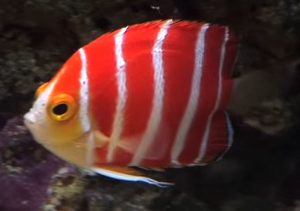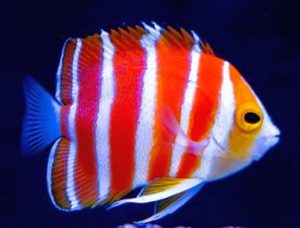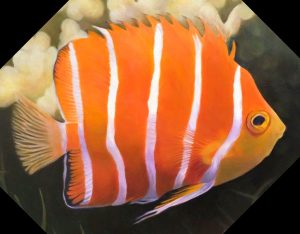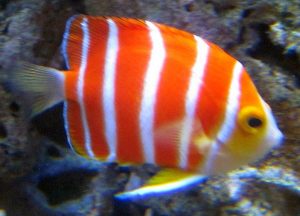The Peppermint Angelfish (Paracentropyge boylei) regarded by tropical fish keeping enthusiasts as the Holy Grail of saltwater fish, is a dwarf deep water species of pygmy angelfish found in the eastern central Pacific around the Cook Islands and Rarotonga in depths between 160, to over 400 feet.
A shy species that hides amongst the rocks and rubble of reef cliffs and most often seen between 300 and 400 feet, the Peppermint Angelfish (Centropyge boylei) was first discovered by Charles Boyle around the Cook Islands. They may be more widespread, but because of the difficulties of sampling deep reef environments, their precise distribution remains unknown.
During a trip made this February to Moorea, a moderately sized island in the middle of the Pacific Ocean in French Polynesia, Dave Pence took the only known video of the Peppermint Angelfish in it’s natural habitat at a depth of between 330 to 360 feet.
The video (above) also shows a few undescribed species of Chromis, a couple of anthias species (Pseudanthias privitera and P. ventralis), and the beautiful Bellus angel (Genicanthus bellus), another rare deep water species.
Peppermint Angelfish get their name from their brilliant red to red-orange body color, five vertical white lines along the body that go through the dorsal and rear half of the ventral fins; and yellow highlights in the white face and chin. Fully grown adults are small and only reach a length of about 2-3/4″.
Males and females appear indistinguishable, but like most other Centropyge species, Centropyge boylei are believed to start their adult life as females. Over time, the larger and more dominant individual in a small group or harem will change sex; sometimes within a few days, up to a couple of weeks to become a male.
Because the Peppermint Angelfish is so rare in the aquarium trade, not much is known about its diet or aquarium care, however, a couple of specimens have been successfully housed like other deep water species of this genus.
Peppermint Angelfish do best in a well established reef aquarium of at least 70 gallon capacity with a large quantity of live rock arranged into caves, crevices, and overhangs for them to hide among when they feel threatened. Their deep water habitat requires cooler water temperatures, which means that an aquarium chiller is mandatory to maintain a water temperature of about 72°F. Because they live in a low light environment, dim lighting is also necessary. Peppermint Angelfish assumedly do well with other deep water tankmates from the Cook Islands such as Ventralis Anthias, etc.
Although a reef setting is optimal, underfed Centropyge boylei will nip at clam mantles, large polyp stony corals, sea anemones, and some soft corals such as zoanthids. Most fish will not eat the coral polyps but instead go after the coral produced mucus.
Angelfish will generally leave Bubble corals, Star polyps, Disc anemones, Hammer corals, and most SPS corals alone, so it is possible to maintain a mixed coral aquarium with dwarf angelfish.
Although Peppermint Angelfish are believed to be broadcast spawners; nothing is known about the breeding habits of this species.
In their natural deep water habitat, Peppermint Angelfish feed on microalgae and detritus. In an aquarium environment, they will require a large amount of live rock to graze on with a variety of copepods as a natural food source and additional offerings of Spirulina, fresh vegetable matter, nori, Mysis shrimp
, Calanus, live or thawed frozen brine shrimp, small fish eggs, Angel Formula
, etc.
If there is not sufficient algae on the live rock for Centropyge boylei to graze on, they must be feed more frequently with supplements of algae rich foods e.g. Spirulina. Once they begin to eat, they will feed on a variety of foods and leave the corals and clams alone.
Although Peppermint Angelfish are not considered a rare fish in their natural habitat, they are almost nonexistent in the aquarium trade. This is because of the difficulty in collecting specimens. They are only located in depths of 160 feet or more where only trained scuba divers can reach them. They are small, shy, elusive, and quickly dart into the rocks when threatened making them difficult for divers to catch, and because they also need to be decompressed as they are brought to the surface, they demand high prices when they are captured.
Peppermint Angelfish (Paracentropyge boylei) specimens that have entered the tropical fish keeping hobby the United States were extremely expensive. The least expensive specimen we have seen was priced at $18,500.00 and the highest price paid was reported to be $30,000.00.
Minimum Tank Size: 70 gallons
Aquarium Type: Deepwater Reef
Care Level: Difficult
Temperament: Peaceful
Aquarium Hardiness: Hardy when acclimated
Water Conditions: 68-74°F, dKH 8 to 12 , pH 7.9 – 8.4, sg 1.020-1.027
Max. Size: 2.75″
Color Form: Red, White, Yellow
Diet: Omnivore
Compatibility: Reef w/Caution
Origin: Indonesia, Rarotonga, Cook Islands.
Family: Pomacanthidae
Lifespan: Up to 10 years
Aquarist Experience Level: Expert






One Response to “Peppermint Angelfish (Paracentropyge boylei)”
Trackbacks/Pingbacks
[…] the aquarium trade Centropyge nigriocella are even more rare and expensive than the deepwater Peppermint Angelfish (Paracentropyge boylei). To date only three specimens have been known to be collected alive, with the latest specimen […]